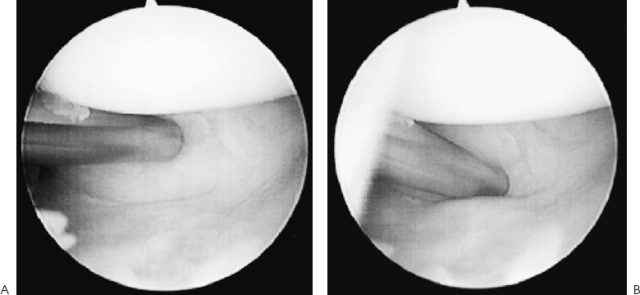66
Tears of the Triangular Fibrocartilage Complex
Philip E. Blazar and Scott D. Mair
History and Clinical Presentation
A 19-year-old right hand dominant college student presented for evaluation of left wrist pain 5 months after closed treatment for a distal radius fracture. The pain was ulnar sided and associated with activities, particularly those involving maximal extension or pronation/supination against resistance (e.g., turning a doorknob on a heavy door). There was no clicking. The patient’s injury had been treated in a long-arm cast for 8 weeks. Office notes from the referring physician document a diagnosis of distal radius fracture and distal radioulnar joint (DRUJ) dislocation reduced and treated in a closed manner. The patient was referred for persistent ulnar sided wrist pain.
PEARLS
- Patients with injuries to the wrist, particularly displaced distal radius fractures, should be examined after reduction for instability of the DRUJ.
- The majority of patients presenting with ulnar-sided wrist pain can be managed non-operatively and returned to normal activities.
- The central component of the TPCC can be excised to a stable rim without compromising its biomechanical function.
PITFALLS
- The differential diagnosis of ulnar-sided wrist pain is lengthy. A careful examination of the ulnar side of the wrist will frequently rule in other causes of patient’s symptoms.
- The dorsal branch of the ulnar nerve crosses from volar to dorsal in the region of ulnar (6U) wrist arthroscopy portals. Careful dissection and protection of this nerve is mandatory to prevent complications.
Physical Examination
The hand, wrist, elbow, and shoulder were normal to inspection. There was minimal atrophy of the forearm musculature. Active range of motion of all joints was symmetric bilaterally. There was tenderness to palpation radial to the ulnar styloid with the arm in neutral rotation and mild discomfort, but no increased translation with stressing the DRUJ. TFCC grind maneuver produced no pain or clicking. The extensor carpi ulnaris (ECU) tendon did not subluxate out of its groove, and wrist instability maneuvers caused minimal discomfort and no clunking. Neurologic and vascular examinations were normal.
Diagnostic Studies
Anteroposterior, lateral, and oblique radiographs of the wrist were obtained (Fig. 66-1).
Differential Diagnosis
Ulnar styloid nonunion
TFCC tear
Ulnocarpal abutment
DRUJ incongruity
Distal radius malunion
ECU tendinitis

Diagnosis
Triangular Fibrocartilage Complex (TFCC) Tear
Ulnar-sided wrist pain is a common complaint. The patient’s age, hand dominance, avocations, and occupation are important historical factors, and the nature and date of injury should be sought. Patterns of injury have been associated with particular recreational activities (e.g., hook of the hamate fractures with sports involving a bat or club). Neurologic complaints are common and should be sought. The differential diagnosis above is limited to the diagnoses likely after a distal radius fracture.
Stay updated, free articles. Join our Telegram channel

Full access? Get Clinical Tree








